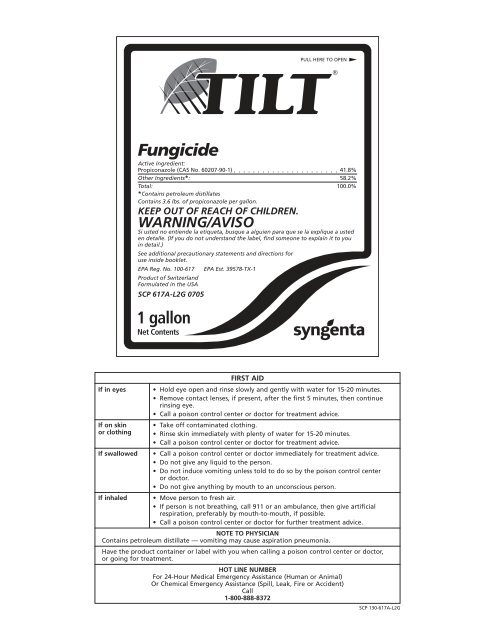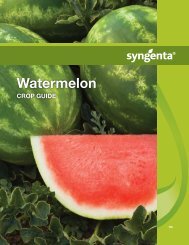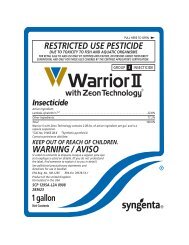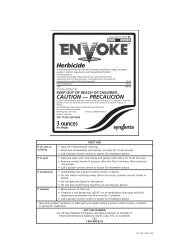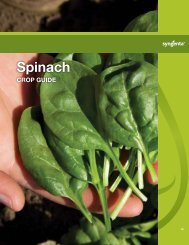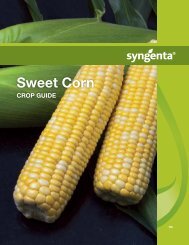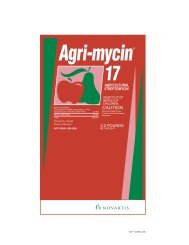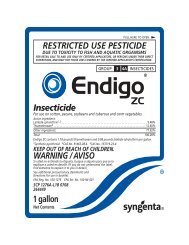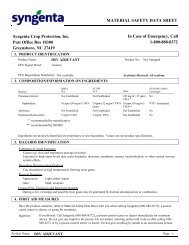Fungicide 1 gallon
warning/aviso - Syngenta
warning/aviso - Syngenta
You also want an ePaper? Increase the reach of your titles
YUMPU automatically turns print PDFs into web optimized ePapers that Google loves.
DIRECTIONS FOR USEIt is a violation of Federal law to use this product in a manner inconsistent with its labeling.Do not apply this product in a way that will contact workers or other persons, either directly orthrough drift. Only protected handlers may be in the area during application. For any requirementsspecific to your State or Tribe, consult the agency responsible for pesticide regulation.AGRICULTURAL USE REQUIREMENTSUse this product only in accordance with its labeling and with the Worker Protection Standard, 40CFR part 170. This Standard contains requirements for the protection of agricultural workers onfarms, forests, nurseries, and greenhouses, and handlers of agricultural pesticides. It containsrequirements for training, decontamination, notification, and emergency assistance. It also containsspecific instructions and exceptions pertaining to the statements on this label about personalprotective equipment (PPE) and restricted-entry interval. The requirements in this box only applyto uses of this product that are covered by the Worker Protection Standard.Do not enter or allow worker entry into treated areas during the restricted entry interval (REI) of24 hours. Exception: If the product is soil-injected or soil-incorporated, the Worker ProtectionStandard, under certain circumstances, allows workers to enter the treated area if there will be nocontact with anything that has been treated.PPE required for early entry to treated areas that is permitted under the Worker ProtectionStandard and that involves contact with anything that has been treated, such as plants, soil, orwater is:• Coveralls• Chemical-resistant gloves, such as barrier laminate or viton• Shoes plus socks• Protective eyewearNON-AGRICULTURAL USE REQUIREMENTSThe requirements in this box apply to uses of this product that are NOT within the scope of theWorker Protection Standard for agricultural pesticides (40 CFR Part 170). The WPS applies whenthis product is used to produce agricultural plants on farms, forests, nurseries, or greenhouses.Do not enter treated areas without protective clothing until sprays have dried.GENERAL INFORMATIONTilt is a broad spectrum fungicide recommended for the control of many important plant diseases.FAILURE TO FOLLOW DIRECTIONS AND PRECAUTIONS ON THIS LABEL MAY RESULT IN CROP INJURY,POOR DISEASE CONTROL, OR ILLEGAL RESIDUES.GENERAL USE PRECAUTIONSTilt ®Important: Do not use Tilt in greenhouses or as a tree injection.Rotational CropsSoybeans may be planted as a double crop following a cereal crop which has been treated with Tilt.Do not use hay, forage, or fodder from the soybean crop as any component of animal feed orbedding.To avoid possible illegal residues, do not plant any other crop intended for food, grazing, or any componentof animal feed or bedding within 105 days of Tilt application to the preceding crop, unless thesecond crop appears on this label.Spray EquipmentThorough coverage is necessary to provide good disease control.To avoid spray drift, do not apply when conditions favor drift beyond the target area. Avoid sprayoverlap, as crop injury may occur.Equip sprayers with nozzles that provide accurate and uniform application. Be certain that nozzles arethe same size and uniformly spaced across the boom. Calibrate sprayer before use.Use a pump with capacity to: (1) maintain 35-40 psi at nozzles, and (2) provide sufficient agitation intank to keep mixture in suspension – this requires recirculation of 10% of tank volume per minute.Use a jet agitator or liquid sparge tube for agitation. Do not air sparge.Although Tilt is an emulsifiable concentrate, it is suggested that screens be used to protect the pumpand to prevent nozzles from clogging. Screens placed on suction side of pump should be 16-mesh orcoarser. Do not place a screen in the recirculation line. Use 50-mesh or coarser screens between thepump and boom, and where required, at the nozzles. Check nozzle manufacturer’s recommendations.For more information on spray equipment and calibration, consult sprayer manufacturers and staterecommendations. For specific local directions and spray schedules, consult the current state agriculturalrecommendations.
Tilt ®Application InstructionsAerial Application: For those crops where aerial applications are indicated, apply in a minimum of5 gals. of water per acre, unless specified otherwise. Avoid application under conditions when uniformcoverage cannot be obtained or when excessive spray drift may occur. Do not apply directly to humansor animals.Ground Application: Apply Tilt by ground equipment in a minimum of 10 gals. of water per acre,unless specified otherwise.Application Through Irrigation Systems (Chemigation) – Apply Tilt through irrigation equipment onlyto crops for which chemigation is specified on this label.Tilt alone or in combination with other pesticides which are registered for application through irrigationsystems, may be applied through irrigation systems. Apply this product only through center pivot,solid set, hand move, or moving wheel irrigation systems. Do not apply this product through any othertype of irrigation system. Crop injury, lack of effectiveness, or illegal pesticide residues in the crop canresult from non-uniform distribution of treated water. If you have questions about calibration, youshould contact State Extension Service specialists, equipment manufacturers, or other experts. Do notconnect an irrigation system (including greenhouse systems) used for pesticide application to a publicwater system, unless the pesticide label-prescribed safety devices for public water systems are in place.A person knowledgeable of the chemigation system and responsible for its operation, or under thesupervision of the responsible person, shall shut the system down and make necessary adjustmentsshould the need arise.Note: Do not inject Tilt at full strength or deterioration of valves and seals may occur. Use a dilutionratio of at least 10 parts water to 1 part Tilt. Tilt is corrosive to many seal materials. Leather seals arebest. EPDM or silicone rubber seals can be used, but should be replaced once a year. Do not use Viton,Buna-N, Neoprene, or PVC seals.Operating Instructions1. The system must contain a functional check-valve, vacuum relief valve, and low pressure drainappropriately located on the irrigation pipeline to prevent water-source contamination from backflow.2. The pesticide injection pipeline must contain a functional, automatic, quick-closing check-valve toprevent the flow of fluid back toward the injection pump.3. The pesticide injection pipeline must also contain a functional, normally closed, solenoid-operatedvalve located on the intake side of the injection pump and connected to the system interlock toprevent fluid from being withdrawn from the supply tank when the irrigation system is eitherautomatically or manually shut down.4. The system must contain functional interlocking controls to automatically shut off the pesticideinjection pump when the water pump motor stops.5. The irrigation line or water pump must include a functional pressure switch which will stop thewater pump motor when the water pressure decreases to the point where pesticide distribution isadversely affected.6. Systems must use a metering pump, such as a positive displacement injection pump (e.g.,diaphragm pump), effectively designed and constructed of materials that are compatible with pesticidesand capable of being fitted with a system interlock.7. Do not apply when wind speed favors drift beyond the area intended.Center Pivot Irrigation EquipmentNotes: (1) Use only with drive systems which provide uniform water distribution. (2) Do not use endguns when chemigating Tilt through center pivot systems because of non-uniform application.• Determine the size of the area to be treated.• Determine the time required to apply 1 /8- 1 /2 inch of water over the area to be treated when the systemand injection equipment are operated at normal pressures as recommended by the equipmentmanufacturer. When applying Tilt through irrigation equipment use the lowest obtainable watervolume while maintaining uniform distribution. Run the system at 80-95% of the manufacturer’srated capacity.• Using water, determine the injection pump output when operated at normal line pressure.• Determine the amount of Tilt required to treat the area covered by the irrigation system.• Add the required amount of Tilt and sufficient water to meet the injection time requirements tothe solution tank.• Make sure the system is fully charged with water before starting injection of the Tilt solution. Timethe injection to last at least as long as it takes to bring the system to full pressure.• Maintain constant solution tank agitation during the injection period.• Continue to operate the system until the Tilt solution has cleared the sprinkler head.Solid Set, Hand Move, and Moving Wheel Irrigation Equipment• Determine the acreage covered by the sprinklers.• Fill injector solution tank with water and adjust flow rate to use the contents over a 20 to 30-minuteinterval. When applying Tilt through irrigation equipment use the lowest obtainable water volumewhile maintaining uniform distribution.• Determine the amount of Tilt required to treat the area covered by the irrigation system.• Add the required amount of Tilt into the same quantity of water used to calibrate the injectionperiod.
Tilt ®• Operate the system at the same pressure and time interval established during the calibration.• Stop injection equipment after treatment is completed. Continue to operate the system until theTilt solution has cleared the last sprinkler head.Mixing InstructionsPrepare no more spray mixture than is required for the immediate operation. Thoroughly clean sprayequipment before using this product. Agitate the spray solution before and during application. Rinsespray tank thoroughly with clean water after each day’s use and dispose of pesticide rinsate by applicationto an already treated area.Important: For wheat, barley, rye, and rice, custom applicators must use a closed system for mixing andloading this product.Tilt Alone: Add 1 /2- 2 /3 of the required amount of water to the spray or mixing tank. With the agitatorrunning, add the Tilt to the tank. Continue agitation while adding the remainder of the water. Beginapplication of the spray solution after the Tilt has completely dispersed into the mix water. Maintainagitation until all of the mixture has been sprayed.Tilt + Tank Mixtures: Tilt is usually compatible with all tank mix partners listed on this label. To determinethe physical compatibility of Tilt with other products, use a jar test. Using a quart jar, add theproportionate amounts of the products to 1 qt. of water. Add wettable powders and water dispersiblegranular products first, then liquid flowables, and emulsifiable concentrates last. After thoroughlymixing, let stand for at least 5 minutes. If the combination remains mixed or can be remixed readily,it is physically compatible. Once compatibility has been proven, use the same procedure for addingrequired ingredients to the spray tank.Add 1 /2- 2 /3 of the required amount of water to the spray or mixing tank. With the agitator running,add the tank mix partner into the tank. Allow the material to completely dissolve and disperse intothe mix water. Continue agitation while adding the remainder of the water and the Tilt to the spraytank. Allow the Tilt to completely disperse. Spray the mixture with the agitator running.If using Tilt in a tank mixture, observe all directions for use, crops/sites, use rates, dilution ratios, precautions,and limitations which appear on the tank mix product label. No label dosage rate should beexceeded, and the most restrictive label precautions and limitations should be followed. This productshould not be mixed with any product which prohibits such mixing. Tank mixtures or other applicationsof products referenced on this label are permitted only in those states in which the referencedproducts are registered.CELERYEarly blight (Cercospora apii) and late blight (Septoria apicola): Apply 4 fl. oz./acre of Tilt on a 7-dayschedule, either by ground or aerial application. If desired, Tilt may be tank-mixed with an appropriatespreader-sticker.Notes: To avoid possible illegal residues, (1) Do not apply more than 16 fl. oz./acre of Tilt per crop, and(2) Do not apply during the last 14 days before harvest.CEREALSWheat, Barley, Rye, Triticale and OatsTilt controls leaf diseases caused by rusts (Puccinia spp.), powdery mildew (Erysiphe spp.), leaf blightand glume blotch (Septoria spp.), tan spot (Pyrenophora tritici-repentis), Helminthosporium leafblight, spot blotch (Bipolaris sorokiniana), barley scald (Rhynchosporium secalis), and net blotch(Pyrenophora teres) and suppression of Fusarium head blight. Highest yields are normally obtainedwhen Tilt is applied to the emerging flag leaf. Tilt can be applied until the ligule of the flag leafemerges, (Feekes growth stage 9) on barley, rye, oats and triticale. For wheat only, Tilt can be applieduntil full head emergence (Feekes growth stage 10.5). Do not apply after this growth stage to avoidpossible illegal residues. Tilt may be applied earlier if disease symptoms appear (especially applicableto barley).Tilt may be applied by ground or aerial application or through irrigation equipment.Early season leaf disease suppression: Apply 2-4 fl. oz./acre of Tilt for suppression of tan spot,Septoria, and powdery mildew.Foot rot (Pseudocercosporella spp.) in wheat: Apply 4 fl. oz./acre of Tilt plus half rates of other EPAregisteredfungicides such as Topsin® M. Apply at tillering, but before elongation has occurred. Donot apply more than 4 fl. oz./acre of Tilt per season.Leaf disease control: Apply 4 fl. oz./acre of Tilt at first appearance of disease. Protecting the flag leafis important for maximizing the potential yield.Notes: To avoid possible illegal residues: (1) Do not apply more than 4 fl. oz./acre of Tilt per season.(2) Do not apply to oats within 40 days of harvest. (3) Do not graze, or feed livestock treated wheat,barley, triticale or rye forage or cut the green crop for hay or silage. After harvest, the straw fromthese crops may be used for bedding or feed. (4) Tilt-treated oat forage may be grazed, and oat forageand hay may be fed to livestock.
Tilt ®CORN (FIELD CORN, FIELD CORN GROWN FOR SEED, SWEET CORN,AND POPCORN)For control of foliar diseases caused by Helminthosporium leaf blights (Helminthosporium maydis, H.turcicum, and H. carbonum), rusts (Puccinia spp.), gray leaf spot (Cercospora zeae-maydis), and eyespot (Aureobasidium zeae), apply Tilt by ground or aerial application or through irrigation equipmentaccording to the following schedule:Helminthosporium Leaf Blights: Apply 2-4 fl. oz./acre of Tilt when disease first appears and continueon a 7 to 14-day schedule.Rusts: Apply 4 fl. oz./acre of Tilt when rust pustules first appear and continue on a 7 to 14-day schedule.Gray Leaf Spot and Eye Spot: Apply 4 fl. oz./acre of Tilt when disease first appears. If conditions favorablefor disease persist, continue to apply on a 14-day schedule.Important: To avoid possible illegal residues: (1) Do not apply Tilt to field corn and field corn grownfor seed after silking. (2) Do not apply more than 16 fl. oz./acre of Tilt per season. (3) Do not apply tosweet corn within 14 days of harvest. (4) Do not harvest field corn, field corn grown for seed, or popcornfor forage within 30 days of application. (5) Do not harvest sweet corn for forage within 14 daysof application.GRASSES GROWN FOR SEED (NEBRASKA, OREGON, WASHINGTON, IDAHO,AND MINNESOTA ONLY)Tilt controls rusts (Puccinia spp.), powdery mildew (Erysiphe spp.), and Selenophoma stem eyespot(Selenophoma) in perennial ryegrass, fescues, bluegrass, orchardgrass, and/or wheatgrasses.Mix 4-8 fl. oz. of Tilt (maximum 4 fl. oz. on bluegrass) in a minimum of 20 gals. of water per acre forground application, or in a minimum of 10 gals. of water per acre for aerial application. Tilt may alsobe applied through irrigation equipment. Apply when powdery mildew and Selenophoma infectionsor rust pustules are noticeable and increasing in number, in late spring or early summer. Repeat at 14to 21-day intervals. To maximize control under severe rust pressure, use the higher rate of 8 fl. oz./acre(except on bluegrass), and make applications at 14-day intervals until the seed is mature. Do not applymore than 32 fl. oz./acre of Tilt per growing cycle. Make the last application at least 20 days beforeseed matures. For bluegrass, it is important to begin application early in the growing season.Ergot Suppression (Idaho, Oregon, and Washington Only): Apply 4-8 fl. oz. Tilt prior to anthesis usinga minimum of 20 <strong>gallon</strong>s of water per acre with ground equipment or a minimum of 10 <strong>gallon</strong>s ofwater per acre with aerial equipment. Under severe disease conditions, or periods of extended bloom,make a second application 7-10 days later. For ergot suppression, do not make more than two applicationsper growing season. For best results, tank mix Tilt with an appropriate surfactant. Do not applymore than 16 fl. oz. of Tilt per acre per growing cycle for ergot suppression. Make last application atleast 20 days before seed matures.Important: To avoid possible illegal residues, do not: (1) feed hay cut within 20 days of the last application,or (2) graze treated areas within 140 days of the last application.MINT (OREGON, WASHINGTON ONLY – WEST OF THE CASCADE MOUNTAINS)Tilt controls rust (Puccinia menthae). Apply 4 fl. oz. Tilt in a minimum of 20 <strong>gallon</strong>s of water per acreper ground application. Begin applications when plants are 2-4 inches high, or when conditionsbecome favorable for disease development. Make a second application 10-14 days after the firstapplication.To avoid possible illegal residues, do not: (1) apply within 90 days of harvest, and (2) do not exceed 8fl. oz. of product per acre per year.PEANUTSTilt may be applied via ground, aerial, or chemigation equipment.Peanuts – Tilt Alone For Foliar Disease ControlLate Leaf Spot (Cercosporidium personatum) – Apply 4 fl. oz./acre of Tilt beginning applications 35-40days after planting or at the first appearance of disease. Continue applications on a 10 to 14-dayschedule. Tilt also may be used in State Agricultural Extension advisory (disease forecasting) programswhich recommend application timing based on environmental factors favorable for disease development.Early Leaf Spot (Cercospora arachidola) – Apply 2.5-4 fl. oz./acre of Tilt beginning applications 35-40days after planting or at the first appearance of disease. Continue applications on a 14-day schedule.Under heavy disease pressure use higher recommended application rates. Tilt also may be used inState Agricultural Extension advisory (disease forecasting) programs which recommend applicationtiming based on environmental factors favorable for disease development.Rust (Puccinia arachidis) – Apply 4 fl. oz./acre of Tilt beginning when pustules first appear. Continueon a 14-day schedule.
Tilt ®Important: To avoid possible illegal residues: (1) Do not apply more than 16 fl. oz./acre of Tilt per season.(2) Do not apply within 14 days of harvest.Peanuts – Tilt Plus Chlorothalonil For Foliar Disease ControlEarly and Late Leaf Spot and Rust – Combinations of Tilt with products containing chlorothalonil maybe used for early and late leaf spot control. Apply 2 fl. oz./acre of Tilt as a tank mixture with 0.75 lb.active ingredient chlorothalonil per acre. Use the following table as a guide to determine the appropriateamount of chlorothalonil to use in the tank mixture. Begin applications 35-40 days after plantingor at the first appearance of disease and continue applications on a 10 to 14-day schedule. Tilt pluschlorothalonil also may be used in State Agricultural Extension advisory (disease forecasting) programswhich recommend application timing based on environmental factors favorable for diseasedevelopment.Important: Use the following table as a guide to determine the amount of product needed for therecommended tank mix ratios of Tilt with various chlorothalonil formulations. To avoid possible illegalresidues: (1) Do not apply more than 16 fl. oz./acre of Tilt per season. (2) Do not apply within 14days of harvest. (3) Do not graze livestock in treated area. (4) Do not feed hay or threshings fromtreated fields to livestock.Amount of chlorothalonilproduct required fortreated area byformulation type (totalacres to be treated)Amount of TiltNumber of required for treated 6 lbs.acres to area (total acres to a.i.be treated be treated) per Gallon101 2 fl. oz. ( 1 /8 pt.) 1 pt.105 10 fl. oz. ( 5 /8 pt.) 5 pts.110 1.25 pts. 10 pts.150 6.25 pts. 50 pts.100 12.50 pts. 100 pts.Peanuts – Tilt Alone for Southern Stem Rot ControlFor the control of Southern Stem Rot (Sclerotium rolfsii), apply Tilt using one of the followingschedules:A. Apply 4 fl. oz./acre of Tilt to the crown and pegging zones of the plant using chemigation ordirected ground application. Begin applications 45 days after planting, or at the first appearanceof disease, and repeat on a 14-day schedule.Important: To avoid possible illegal residues: (1) Do not apply more than 16 fl. oz./acre of Tilt perseason. (2) Do not apply within 14 days of harvest.B. Apply 8 fl. oz./acre of Tilt to the crown and pegging zones of the plant using chemigation ordirected ground application. Make 2 applications: the first at pegging (approximately 60 daysafter planting) or at the first appearance of disease, and the second application 3-4 weeks later.Irrigation: When applying Tilt in irrigation water for Southern Stem Rot Control of Peanuts, use a minimumof 0.25-0.50 inches of irrigation water per acre. Use enough water so that the fungicide penetratesthe peanut canopy and reaches the crown of the plant where Sclerotium rolfsii is most active.Ground Application: When applying Tilt by ground equipment, use a minimum of 20-60 GPA directedto the crown of the plant where Sclerotium rolfsii is most active. For best disease control, the highercarrier volume is recommended. Canopy openers also may be used to improve fungicide placement.When applying Tilt via irrigation or as a directed ground application, additional methods should beemployed for leaf spot control.Banded Application: For banded applications, the treated area is the area covered by the band, nottotal cropland planted. The following formula can be used to calculate the amount of Tilt needed peracre of crop when banded applications are made.band width in inches broadcast rate amount neededXrow spacing in inchesper acre = per acre of fieldImportant: To avoid possible illegal residues: (1) Do not apply more than 16 fl. oz./acre of Tilt per season.(2) Do not feed hay from treated fields to livestock. (3) Do not apply within 21 days of harvest.PINEAPPLE (HAWAII ONLY)Butt rot disease of pineapple (Ceratocystis paradoxa): Apply 0.75 fl. oz. (22 ml) of Tilt per 100 gals. ofwater (1:17,000). Treatments can be made in either a cold or hot water dip.Cold Water Dip – Immerse crowns to give thorough wetting, remove, and allow to drain.Hot Water Dip – Maintain water temperature at 125°F (52°C). Soak crowns for 20-30 minutes, remove,and allow to drain.Important: To avoid possible illegal residues: (1) Do not use treated crowns for food or feed. (2) Donot graze while plant is growing. (3) Do not graze tops until fruit is harvested. (4) Dispose of used dipsolution according to local, state, and federal regulations.
Tilt ®RICE (DO NOT USE IN CA)In rice, Tilt controls sheath blight (Rhizoctonia solani), brown leaf spot (Helminthosporium oryzae),narrow brown leaf spot and brown blotch (Cercospora oryzae), leaf smut (Entyloma oryzae), sheathspot (Rhizoctonia oryzae), kernel smut (Tilletia barclayana), and black sheath rot (Gaeumannomycesgraminis). Tilt also suppresses stem rot (Sclerotium oryzae) and false smut (Ustilaginoidea virens).Apply Tilt on either of the following schedules as an aerial spray in 5-10 gals. of water per acre:A. 6 fl. oz./acre at first internode elongation (up to 2-inch panicle) and repeat at swollen boot.Make the second application 10-14 days after the first application, but before the boot splitsand head emerges. Tilt provides best control of sheath blight when the first application isapplied at disease appearance in the field. The first application is recommended when 5% orfewer of the tillers are infected.B. 10 fl. oz./acre at first internode elongation (up to 2-inch panicle). The 10 oz. rate is recommendedif greater than 10% of the tillers are infected with sheath blight. If disease reappears,use another registered fungicide for the second application.Important: To avoid possible illegal residues: (1) Do not apply to stubble or ratoon crop rice; (2) Donot use in rice fields where commercial farming of crayfish will be practiced; (3) Do not drain waterfrom treated rice fields into ponds used for commercial catfish farming; and (4) Do not use waterdrained from treated fields to irrigate other crops.Endangered Species Restrictions: The use of Tilt (propiconazole) on rice is restricted to protect theendangered fat pocketbook pearly mussel (Potamilus capax) and its habitat. Use is prohibited in thefollowing areas of AR:Mississippi County -– Within the basin that drains directly into the Right Hand Chute of LittleRiver, south of Big Lake National Wildlife Refuge.Poinsett County -– Between Crowley’s Ridge and the levee east of the Right Hand Chute of LittleRiver and the St. Francis Floodway. Use is also prohibited west of Rt. 140 and north of Rt. 63 atthe siphon near Marked Tree. Except that the prohibited area does not include the area boundedby Arkansas highway 373 on the west, highway 63 on the east, and highway 14 on the south.Cross, St. Francis, and Lee Counties – Between Crowley’s Ridge and the levee east of the RightHand Chute of Little River, and the St. Francis Floodway, as far south as the confluence ofL’Anguille River (Lee County).Wild Rice (MN Only)Helminthosporium leaf blight and brown spot (Bipolaris spp.): Apply 6 fl. oz./acre of Tilt at both bootingand heading, or make a single application of 8 fl. oz./acre at booting. For aerial applications, applyin a spray volume of 5-10 gals./acre.Important: Do not use water drained from treated fields to irrigate other crops.SUGARCANEPineapple disease of sugarcane (Ceratocystis paradoxa): Apply Tilt to cut seed pieces using 0.75 fl. oz.(22 ml) per 100 gals. of water (1:17,000). Treatments can be applied in either a cold or hot water dip.Do not use treated seed pieces for food or feed purposes. Dispose of spent dip solution according tostate and federal regulations.Cold Water Dip – Immerse seed pieces to give thorough wetting, remove, and allow to drain.Hot Water Dip – Maintain water temperature at 125°F (52°C). Soak the seed pieces for 20-30 minutes,remove, and allow to drain.Conveyer Spray Treatment: Add 0.75 fl. oz. (22 ml) of Tilt to 100 <strong>gallon</strong>s of water (1:17000). Treat seedpieces with Tilt/water solution using in-line directed spray sufficient to wet cut ends.STORAGE AND DISPOSALDo not contaminate water, food, or feed by storage or disposal.Pesticide StorageStore in the original container in cool place.Pesticide DisposalPesticide wastes may be toxic. Improper disposal of excess pesticide, spray mixture, or rinsate is a violationof federal law. If these wastes cannot be disposed of by use according to label instructions, contactyour State Pesticide or Environmental Control Agency, or the Hazardous Waste representative ofthe nearest EPA Regional Office for guidance.Container DisposalTriple rinse (or equivalent); then offer for recycling or reconditioning, or puncture and dispose of in asanitary landfill or alternatives allowed by State and local authorities.For Bulk and Minibulk Containers:Container Disposal: Reseal container and offer for reconditioning, or triple rinse (or equivalent) andoffer for recycling or reconditioning, or clean in accordance with manufacturer's instructions.Container Precautions: Before refilling, inspect thoroughly for damage, such as cracks, punctures,bulges, dents, abrasions and damaged or worn threads on closure devices.Refill Only With Tilt. The contents of this container cannot be completely removed by cleaning.Refilling with materials other than Tilt will result in contamination and may weaken container.
Tilt ®After filling and before transporting, check for leaks.Do not refill or transport damaged or leaking container.Tilt® and the Syngenta logo are trademarks of a Syngenta Group CompanyTopsin® is a trademark of Cerexagri, Inc.©2006 SyngentaSyngenta Crop Protection, Inc.Greensboro, North Carolina 27419www.syngenta-us.comSCP 617A-L2G 0705For non-emergency (e.g. current product information) callSyngenta Crop Protection at 1-800-334-9481.
Tilt ®<strong>Fungicide</strong>Active Ingredient:Propiconazole (CAS No. 60207-90-1) . . . . . . 41.8%Other Ingredients*: 58.2%Total: 100.0%*Contains petroleum distillatesContains 3.6 lbs. of propiconazole per<strong>gallon</strong>.AGRICULTURAL USE REQUIREMENTSUse this product only in accordance withits labeling and with the WorkerProtection Standard, 40 CFR part 170.Refer to supplemental labeling under“Agricultural Use Requirements” in theDirections for Use section for informationabout this standard.EPA Reg. No. 100-617EPA Est. 39578-TX-1Product of SwitzerlandFormulated in the USATilt® and the Syngenta logo are trademarksof a Syngenta Group Company©2006 SyngentaSyngenta Crop Protection, Inc.Greensboro, North Carolina 27419www.syngenta-us.comSCP 617A-L2G 07051 <strong>gallon</strong>Net Contents® KEEP OUT OF REACHOF CHILDREN.WARNING/AVISOSi usted no entiende la etiqueta,busque a alguien para que se laexplique a usted en detalle. (If you donot understand the label, find someoneto explain it to you in detail.)See additional precautionary statementsand directions for use insidebooklet.Precautionary StatementsHazards to Humans and DomesticAnimalsCauses substantial but temporary eyeinjury. Do not get in eyes, on skin, oron clothing. Harmful if swallowed,inhaled, or absorbed through skin.Avoid breathing spray mist. This productmay cause skin sensitization reactionsin certain individuals.FIRST AIDIf in eyes: Hold eye open and rinseslowly and gently with water for 15-20minutes. Remove contact lenses, if present,after the first 5 minutes, then continuerinsing eye. Call a poison controlcenter or doctor for treatment advice.If on skin or clothing: Take off contaminatedclothing. Rinse skin immediatelywith plenty of water for 15-20 minutes.Call a poison control center or doctorfor treatment advice.If swallowed: Call a poison control centeror doctor immediately for treatmentadvice. Do not give any liquid to theperson. Do not induce vomiting unlesstold to do so by the poison control centeror doctor. Do not give anything bymouth to an unconscious person.If inhaled: Move person to fresh air. Ifperson is not breathing, call 911 or anambulance, then give artificial respiration,preferably by mouth-to-mouth, ifpossible. Call a poison control center ordoctor for further treatment advice.NOTE TO PHYSICIAN: Contains petroleumdistillate – vomiting may causeaspiration pneumonia.Have the product container or labelwith you when calling a poison controlcenter or doctor, or going fortreatment.HOT LINE NUMBER: For 24-Hour MedicalEmergency Assistance (Human orAnimal) Or Chemical Emergency Assistance(Spill, Leak, Fire or Accident) Call1-800-888-8372.Environmental HazardsThis pesticide is toxic to fish. For terrestrialuses, do not apply directly towater, or to areas where surface wateris present, or to intertidal areas belowthe mean high water mark. Do notcontaminate water when disposing ofequipment wash water. Refer to productlabeling for use restrictions to protectendangered species.Physical or Chemical HazardsDo not use, pour, spill, or store nearheat or open flame.STORAGE ANDDISPOSALDo not contaminate water, food, orfeed by storage or disposal.Pesticide StorageStore in the original container in coolplace.Pesticide DisposalPesticide wastes may be toxic.Improper disposal of excess pesticide,spray mixture, or rinsate is a violationof federal law. If these wastes cannotbe disposed of by use according tolabel instructions, contact your StatePesticide or Environmental ControlAgency, or the Hazardous Waste representativeof the nearest EPA RegionalOffice for guidance.Container DisposalTriple rinse (or equivalent); then offerfor recycling or reconditioning, orpuncture and dispose of in a sanitarylandfill or alternatives allowed by Stateand local authorities.ChemigationRefer to supplemental labeling inattached booklet for use directions onchemigation. Do not apply this productthrough any type of irrigation systemunless the supplemental labeling isfollowed.


